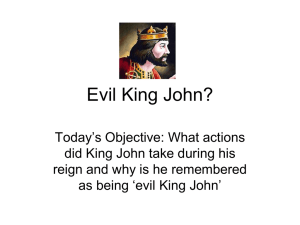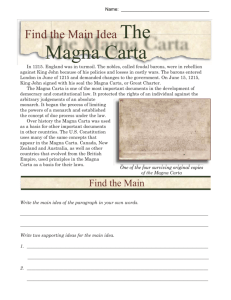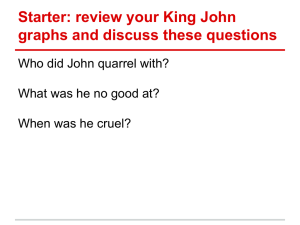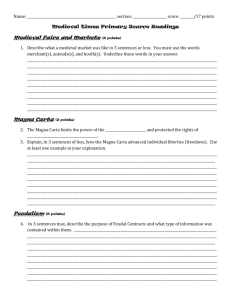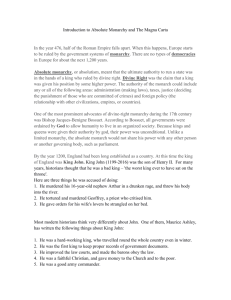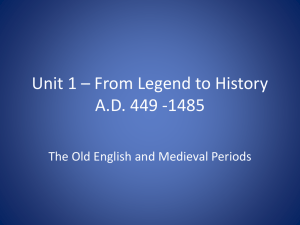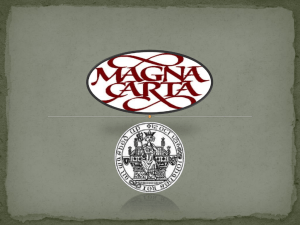File - REPUBLIC OF CALLAMARI
advertisement
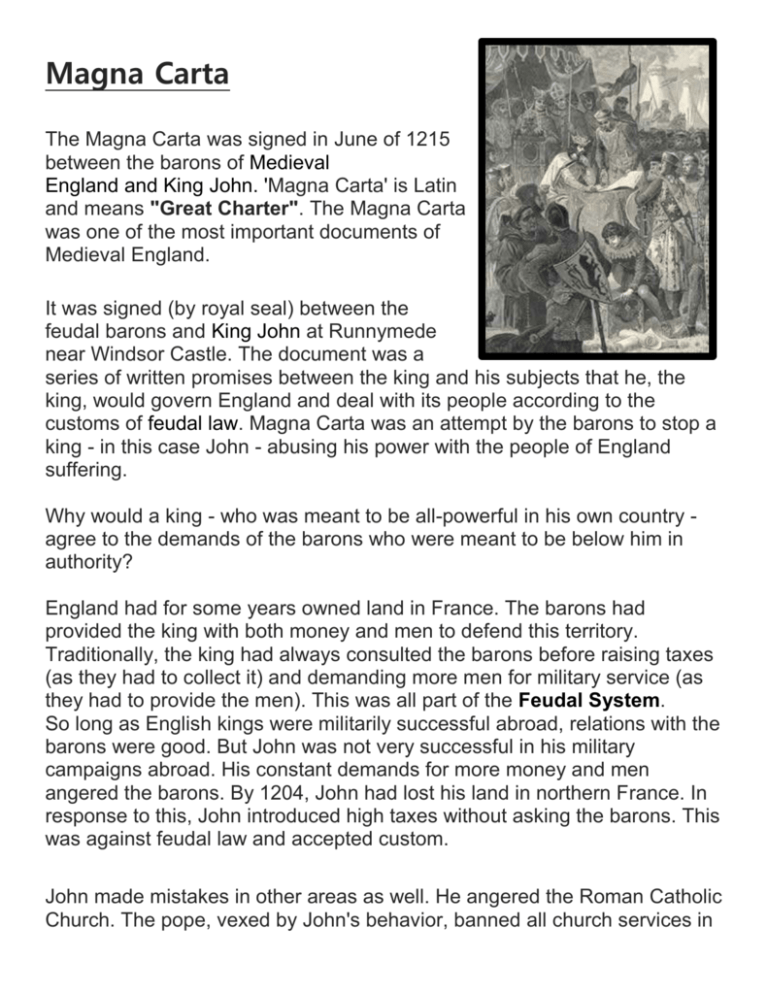
Magna Carta The Magna Carta was signed in June of 1215 between the barons of Medieval England and King John. 'Magna Carta' is Latin and means "Great Charter". The Magna Carta was one of the most important documents of Medieval England. It was signed (by royal seal) between the feudal barons and King John at Runnymede near Windsor Castle. The document was a series of written promises between the king and his subjects that he, the king, would govern England and deal with its people according to the customs of feudal law. Magna Carta was an attempt by the barons to stop a king - in this case John - abusing his power with the people of England suffering. Why would a king - who was meant to be all-powerful in his own country agree to the demands of the barons who were meant to be below him in authority? England had for some years owned land in France. The barons had provided the king with both money and men to defend this territory. Traditionally, the king had always consulted the barons before raising taxes (as they had to collect it) and demanding more men for military service (as they had to provide the men). This was all part of the Feudal System. So long as English kings were militarily successful abroad, relations with the barons were good. But John was not very successful in his military campaigns abroad. His constant demands for more money and men angered the barons. By 1204, John had lost his land in northern France. In response to this, John introduced high taxes without asking the barons. This was against feudal law and accepted custom. John made mistakes in other areas as well. He angered the Roman Catholic Church. The pope, vexed by John's behavior, banned all church services in England in 1207. Religion, and the fear of Hell, were very important to the people including the barons. The Catholic Church taught the people that they could only gain entrance to Heaven if the Catholic Church believed that they were good enough to get there. How could they show their goodness and love of God if the churches were shut? Even worse for John was the fact that the pope excommunicated him in 1209. This meant that John could never get to Heaven until the pope withdrew the excommunication. Faced with this, John climbed down and accepted the power of the Catholic Church, giving them many privileges in 1214. 1214 was a disastrous year for John for another reason. Once again, he suffered military defeat in an attempt to get back his territory in northern France. He returned to London demanding more money from taxes. This time the barons were not willing to listen. They rebelled against his power. The barons captured London. However, they did not defeat John entirely and by the Spring of 1215, both sides were willing to discuss matters. The result was the Magna Carta. What did the Magna Carta do? Filled with 63 clauses and divided into multiple sections, the Magna Carta greatly limited the power of the king. The first clauses concern the position of the Catholic Church in England and its authority over the king. Those that follow state that John will be less harsh on the barons and oppressive of the people. Many of the clauses concern England's legal system. Magna Carta promised laws that were good and fair. It states that everyone shall have access to courts and that costs and money should not be an issue if someone wanted to take a problem to the law courts. It also states that no freeman (i.e. a person who was not a serf) will be imprisoned or punished without first going through the proper legal system. In future years, the word "freeman" was replaced by "no one" to include everybody. The last few sections deal with how the Magna Carta would be enforced in England. Twenty five barons were given the responsibility of making sure the king carried out what was stated in the Magna Carta - the document clearly states that they could use force if they felt it was necessary. To give the Magna Carta an impact, the royal seal of King John was put on it to show people that it had his royal support. Written in Latin, the Magna Carta was effectively the first written constitution in European history. Of its 63 clauses, many concerned the various property rights of barons and other powerful citizens, suggesting the limited intentions of the framers. The benefits of the charter were for centuries reserved for only the elite classes, while the majority of English citizens still lacked a voice in government. In the 17th century, however, two defining acts of English legislation–the Petition of Right (1628) and the Habeas Corpus Act (1679) would extend protection of rights to a majority of English citizens. All things considered, Magna Carta had dramatic implications for future legal systems in Britain and America. In 1776, rebellious American colonists looked to the Magna Carta as a model for their demands of liberty from the English crown. Its legacy is especially evident in the Bill of Rights and the U.S. Constitution, and nowhere more so than in the Fifth Amendment (“Nor shall any persons be deprived of life, liberty or property without due process of law”), which echoes Clause 39 of Magna Carta. Many state constitutions also include ideas and phrases that can be traced directly to the historic document. Magna Carta undoubtedly helped to lead England in the direction of a constitutional government and helped to establish the “Rights of Englishmen.” Questions Please answer in complete sentences on a separate sheet of paper. Be prepared to turn in your work! 1. 2. 3. 4. 5. What is the Magna Carta? Explain the back-story to the why and how the Magna Carta was created. How did the Feudal System lead to the Magna Carta’s creation? What are some of the specific clauses and rights found in the Magna Carta? Explain the influence of the Magna Carta on our Founders and the leading documents of American government.

